
 HMS MONTROSE
HMS MONTROSE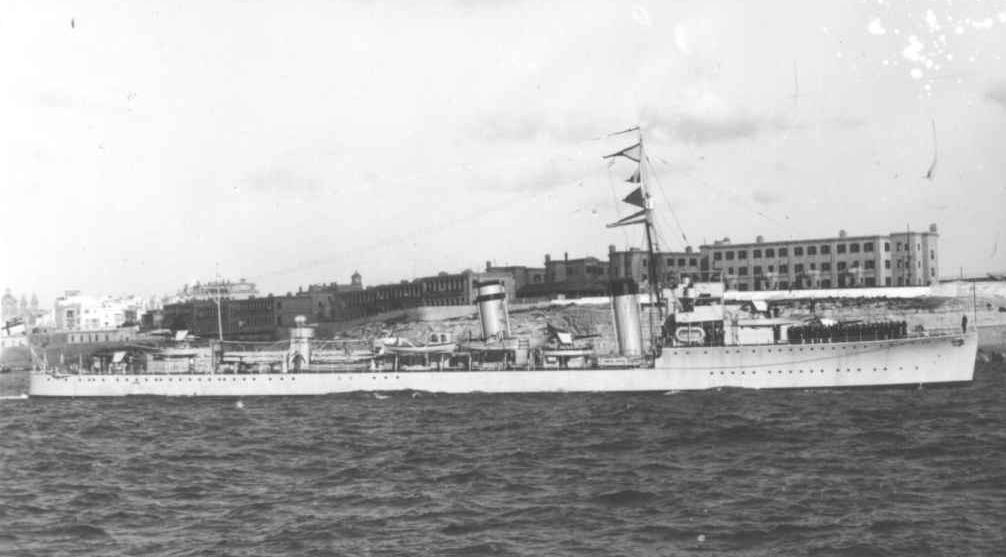
Click on the links within this brief
outline for first hand accounts by the men who served on HMS Montrose and for a more detailed chronology see www.naval-history.net
Commanding Officers
With acknowledgment to the Dreadnought Project and Unithistories.com
| Cdr Malcolm L. Goldsmith, 21 August, 1918 – 4 July, 1919) Cdr Lewis G. E. Crabbe, 4 July, 1919 – 23 February, 1922) Cdr Edward McC. W. Lawrie, 4 February, 1922 – September, 1922) Capt The Hon. Edward B. S. Bingham VC (1 October, 1922 – 1 October, 1924) Capt Edmond J. G. Mackinnon (1 Oct, 1924 – 10 Feb, 1925 - and as Capt (D), 4DF) Capt Edward O. B. S. Osborne (10 Feb, 1925 – Oct, 1925) And as Capt (D), 5DF and 1DF from 1 April, 1925) Capt James V. Creagh (10 Oct 1925 (and as Capt (D), 1DF) Capt John H. K. Clegg (11 Oct, 1927 - and as Capt (D) 2DF) Capt James V. Creagh (Oct, 1927 – 2 July, 1928 - and as Capt (D), 1DF) Lt Cdr Edward D. Marston (23 Oct 1929 – 16 Nov, 1929 - for period of trials) Lt Cdr John Drinkwater (9 Sept 1930 – 4 Dec 1930 - for trials) Capt Arthur J. L. Murray (4 Dec, 1930 – 1931 - and as Capt (D), 6DF) |
Capt Geoffrey R. S. Watkins (late 1931 – 30 June,
1932 - and as Capt (D), 5 DF) Capt Richard S. Benson (1935 – August, 1935 - and as Captain (D), 10 DF) Capt Ernest R. Archer (30 Aug 1935 – 10 Feb 1936 - and as Capt (D), 20 DF) Capt Charles M. Blackman (10 Feb 1936 – mid 1936 - and as Capt (D), 20 DF) Capt Henry B. Crane (24 Sept 1938 – 1938 - and as Capt (D), 9DF) Wartime Commanding officers Cdr (Ret) Henry T. W. Pawsey (31 July – 6 Sept, 1939) Capt Alfred J. L. Phillips (30 Aug – 28 Sept 1939 - and Captain (D) 17 DF) Cdr Cecil R. L. Parry (27 Sept 1939 – 9 Sept 1941) Lt Cdr Walter J. Phipps (9 Sept 1941 – 16 Oct 1943) Cdr Guy N. Rolfe (16 Oct 1943 – c. Aug 1944) |
Officers
Further names from the
Navy List will be added later.
| Lt(E) T.E. Browell (10 Oct 1943 - c. Aug 1944) Lt R. A. Carr RNVR (28 April - c. Aug 1944) Sub Lt Edward John Cornish-Bowden (14 Feb – April 1940) Lt C.J. Cross RNR (4 Oct 1941 - c. Aug 1944) Lt T.D. Evans RNVR (3 May 1943 - c. Aug 1944) Sub Lt J.E.A.R. Guinness RNVR (26 Feb - c Aug 1944) Lt Edward M.B. Hoare RN (28 Sept 1939 - Oct 1940) Surg Lt S.G.F. Linton RNVR (24 July 1943 - c. Aug 1944) |
Lt Cdr Sir Rhoderick R. McGrigor RN (Feb 1925 - May 1926) 1st Lt Guy E.M. Naylor RN (Jan 1941 - Feb 1942) Sub Lt Anthony d'E.T. Sangster (Tony) RN (16 Sept 1941 - Jan 1942) Sub Lt D.V. Sheppard RNVR (18 April 1942 - c. Aug 1944) Lt D.C. Souter RNVR (15 Feb 1944 - c. Aug 1944) Sub Lt J.H. Terry RNVR (28 June 1943 - c. Aug 1944) Lt John V Yelland RN (5 Jan 1940 - Feb 1942) |
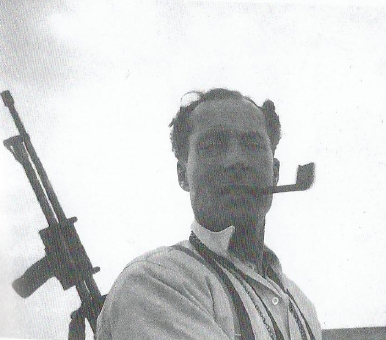 Lt Cdr Walter J Phipps (on left) took command of HMS Montrose on 9 September 1941 while under repair at Chatham after being badly damaged by German bombers near Aldeburgh. HMS Wren was sunk in the same action. In December 1941, HMS Montrose was
detached from her flotilla to join the covering force for Operations
Anklet and Archery, raids on Lofoten and Vågsøy in northern Norway. On
30 December, Montrose hit a rock off Herston, Orkney, damaging her port propeller shaft and was under repair at Rosyth until the end of May 1942.
Lt Cdr Walter J Phipps (on left) took command of HMS Montrose on 9 September 1941 while under repair at Chatham after being badly damaged by German bombers near Aldeburgh. HMS Wren was sunk in the same action. In December 1941, HMS Montrose was
detached from her flotilla to join the covering force for Operations
Anklet and Archery, raids on Lofoten and Vågsøy in northern Norway. On
30 December, Montrose hit a rock off Herston, Orkney, damaging her port propeller shaft and was under repair at Rosyth until the end of May 1942. 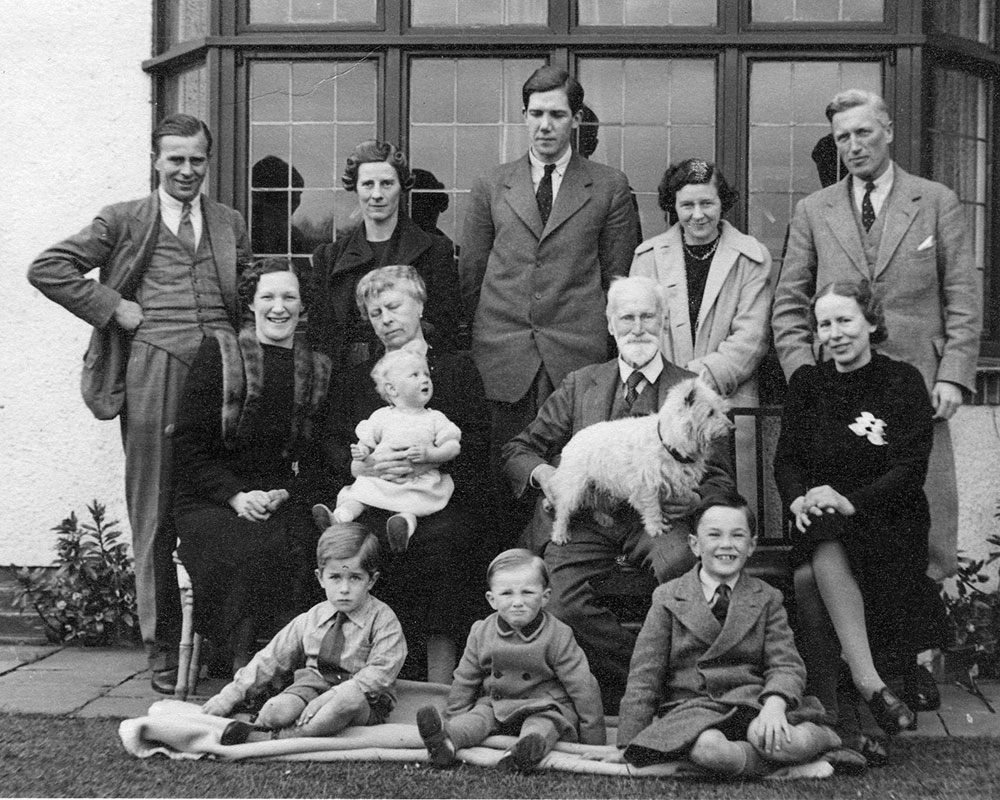
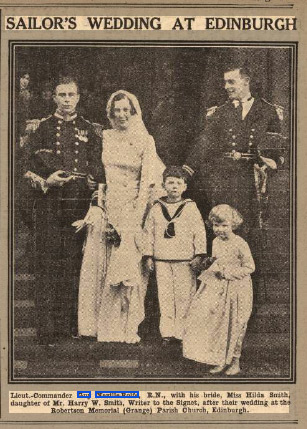 Guy
Neville-Rolfe was born in Naples on 21 November 1898 when his father,
Captain Herbert Neville-Rolfe RN, was 44 and his mother, Mabel Mary
Barff, 29.His Mother was the daughter of the Chaplain of the Anglican
Church in Naples and Canon of Gibraltar. Her family came from the
village of Flax Bourton in North Somerset so he
could claim a Somerset connection through his Mother despite living
near Hunstanton in
Norfolk where his family had lived at Heacham since 1558.
Guy
Neville-Rolfe was born in Naples on 21 November 1898 when his father,
Captain Herbert Neville-Rolfe RN, was 44 and his mother, Mabel Mary
Barff, 29.His Mother was the daughter of the Chaplain of the Anglican
Church in Naples and Canon of Gibraltar. Her family came from the
village of Flax Bourton in North Somerset so he
could claim a Somerset connection through his Mother despite living
near Hunstanton in
Norfolk where his family had lived at Heacham since 1558. 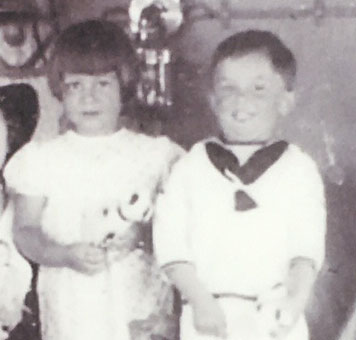 The married couple went to Malta where he was given command of HMS Walrus: "I took over a good ship and we won every efficiency and sports trophy" and after two years was rewarded with command of HMS Cygnet,
a new ship used as a cruiser but with an unpopulsr senior officer.
David Nevill-Rolfe, the first of two sons was christened on board the Cygnet on 24 April 1932 but things did not work out for his father and he was posted to the Chatham naval
base on the Medway" to while away his time" teaching anti-gas techniques at the "Gas School".
The married couple went to Malta where he was given command of HMS Walrus: "I took over a good ship and we won every efficiency and sports trophy" and after two years was rewarded with command of HMS Cygnet,
a new ship used as a cruiser but with an unpopulsr senior officer.
David Nevill-Rolfe, the first of two sons was christened on board the Cygnet on 24 April 1932 but things did not work out for his father and he was posted to the Chatham naval
base on the Medway" to while away his time" teaching anti-gas techniques at the "Gas School". At the outbreak of war he was given command of HMS Whitley, a V & W converted into an anti-aircraft ship by the addition of high attitde 4 inch guns, a WAIR conversion:
"She
was a very happy ship with an active service engine room complement,
and a peacetime RNVR team from Bristol trained for the guns and
control. Unfortunately, we were lent to the French working from Dunkirk
and it was only a matter of time before we were sunk with no
means of informing the Admiralty of the madness."
After HMS Whitley
was severely damaged by aircraft he ran her aground and used her as a
shore battery until all amnumition was expended. There is a detailed
account of the sinking off the Belgium coast on 19 May 1940 by Leading
Telegraphist Anthony W Story on the website of HMS Whitley.
John Murray Neville-Rolfe wrote "Mother had a telephone call to say he
was missing at sea but was able to say that he had telephoned her the
previous evening!" He was awarded the first of his two DSC for this
action.
After the loss of HMS Witley he was appointed as the first CO of the Hunt Class destroyer HMS Mendip in October 1940. Her stern was damaged by the premature explosion of her own depth charges at Scapa Flow during work up exercises and she had to be towed to Middlesborough and was under repair until February 1941. The next two years were spent escorting east coast covoys from Sheerness and Harwich to the Firth of Forth and back, a regular but dangerous routine in which German e-boats and bombers were the main threat. The family folders record these encounters in press cuttings but his Reports of Proceedings in the National Archives would give more detailed description - if they can be found. On 5 February 1942, the day before his 44th birthday, HMS Pytchley and HMD Mendip were bombed by three Dorniers, and the Daily Sketch reported that on 21 February HMS Mendip and HMS Holderness fought off e-boats attacking an east coast convoy.
On 21 April 1942 he was "awarded bar to DSC for skill and enterprise in a successful action against German e-boats". From
the cryptic hand written entries in his Service Certificate it is clear
that his eye sight was damaged in these actions and for the best part
of a year from 28 August 1942 to 22 July 1943 he was discharged
for shore service. His Somerset connections help explain the extensive
coverage Cdr Guy Neville-Rolfe received (below left) in the pages of
the Somerset Standard:
"He
temporarily lost his sight due to a gunflash and continual strain on
the optic nerve. As his sight began to improve, though still unable to
read and dependent on a guide, the Commander toured factories and
dockyards up and down the country giving lectures to the war-workers.
He gave first-hand accounts of E-boat encounters, and other aspects of
the war, in which their products were being employed by the Royal
Navy: 'I had to speak without any notes, of course, but I
thoroughly enjoyed the experience - and the workers were extremely
enthusiastic everywhere' (Somerset Standard 14 July 1944, on left)
Hunting was an essential part of the life
of a country gentleman and Cdr Rolfe joined the Mendip Hunt while on
leave in Somerset. HMS Mendip was adopted by Shepton Mallet after a successful Warship Week in March 1942 and HMS Montrose was adopted by Frome. Today Frome, Mendip and Shepton Mallet are all part of Mendip District Council.
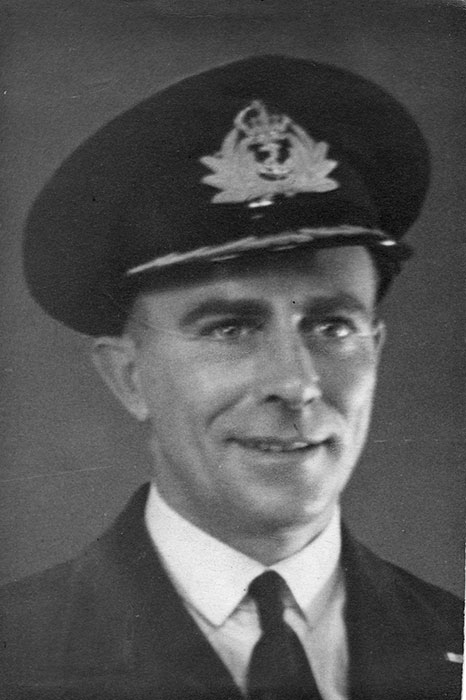 |
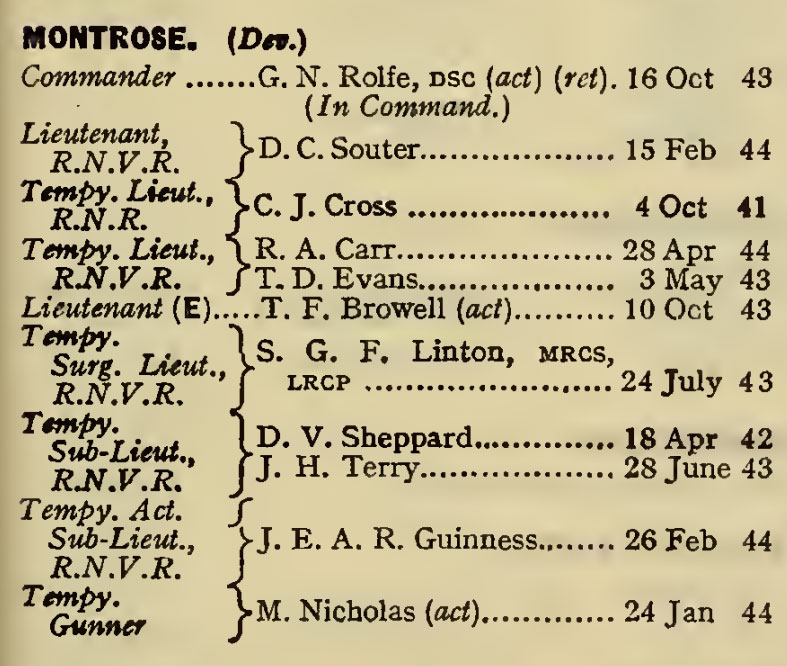 The entry for HMS Montrose in the June 1944 issue of the Naval List.
They were all RNVR or RNR with the exception of Lt(E) Browell and Gunner Nicholas. |
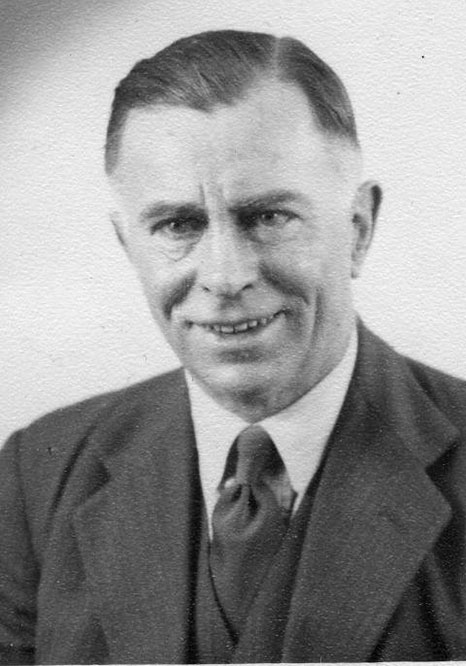 |
 | Both
commanding officers faced a court martial. Cdr Guy
Neville-Rolfe's Service Certificate records that was convicted of having hazarded his ship but his "severe reprimand" was annulled by the
Board of Admiralty on the grounds that: "a)
That the accused was not on the bridge earlier was in their Lordships
opinion insufficient to justify a conviction for negligently
or by default hazarding his ship.
b) Action taken by the accused to avert a collision may not have been the best action in the circumstances, but this does not constitute negligence and Their Lordships dissent from the findings. The sentence was annulled. And officer so informed - through C in C Nore AL (Admiralty Letter) NL33 of 44 dated 15/3/44" Based on age Neville-Rolfe was placed on the Retired List with the rank of Commander on 21 November when he was 45. For the next six months HMS Montrose was escorting East Coast Convoys, fighting off E-Boats and enemy bombers, a hazardous but repetitive routine made familiar from his time as CO of HMS Mendip. HMS Montrose played a prominent part in Operation Neptune,
the D-Day Landings in Normandy. On D-Day she
escorted Convoy ETL1, comprising 12 LST and 27 LCT taking the 7th
Armoured Division, the “Desert Rats” to their landing beach: "As we left England we passed another convoy commaded by Lt Angus Graham RNVR, the Marquis of Graham (son of the Duke of Montrose) in HMS Ludlow.
He had some pipers on the bridge to play the Montrose Skirl which gave
us and particularly the soldiers, a heartening send-off." From 7 June she deployed with a group escorting the Build-up
convoys. A month later on 7 July her stern was damaged in collision with the cargo ship Empire Heywood off Harwich. Montrose suffered
more serious damage on 19 July when she collided with the Landing Ship Tank LST430: "Montrose had a humiliating end by being nearly cut in half
by a Landing Ship Tank (LST) in fog off Normandy on our second or
third trip, but we got both bits home." LST 430 was a 300 ft long ocean crossing ship with a crew
of 117, very different from the Landing Craft Tanks (LCT) which landed
the tanks on the Normandy beaches and much bigger than HMS Montrose
as can be seen by the photographs below. Nothing further is
known about the cause of the collision other than it happened in thick
fog but I hope to locate a photograph showing the damage done. Montrose was placed in Category C Reserve ("mothballed") on 2 November 1944, allocated by BISCO to Hughes Bolckow Ltd for disposal on 31 January 1946 and scrapped at Blyth in Northumberland.
|
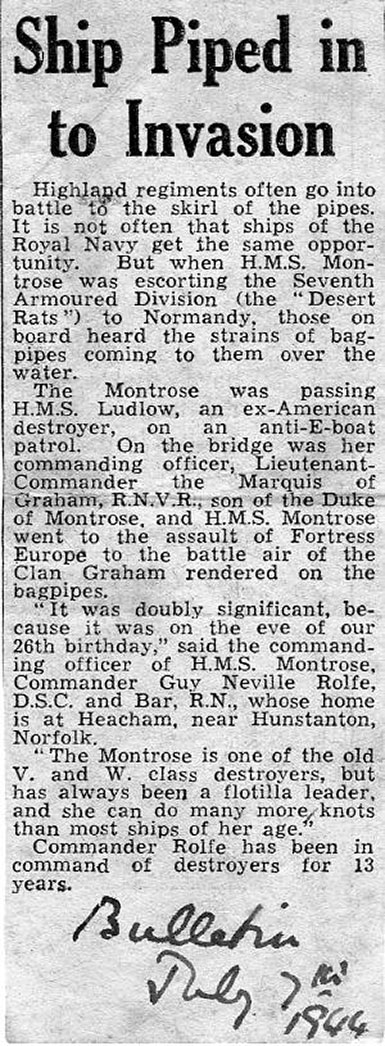 |
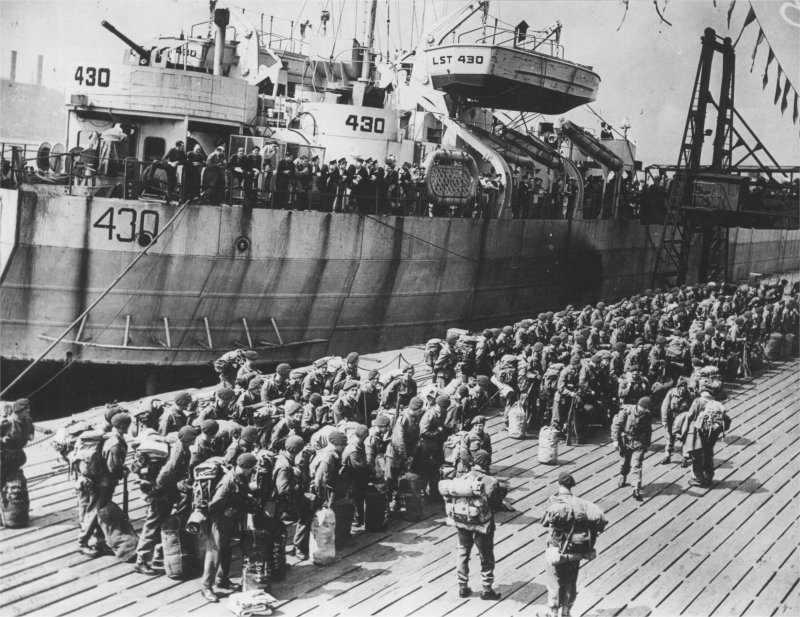 Commando disembarking from HM LST-430 at Tilbury The collision with HMS Montrose brought an end to her thirty years service in the Royal Navy Photograph courtesy of Keith Stockwell for his father Bernard W. Stockwell, Quartermaster HM LST-430 |
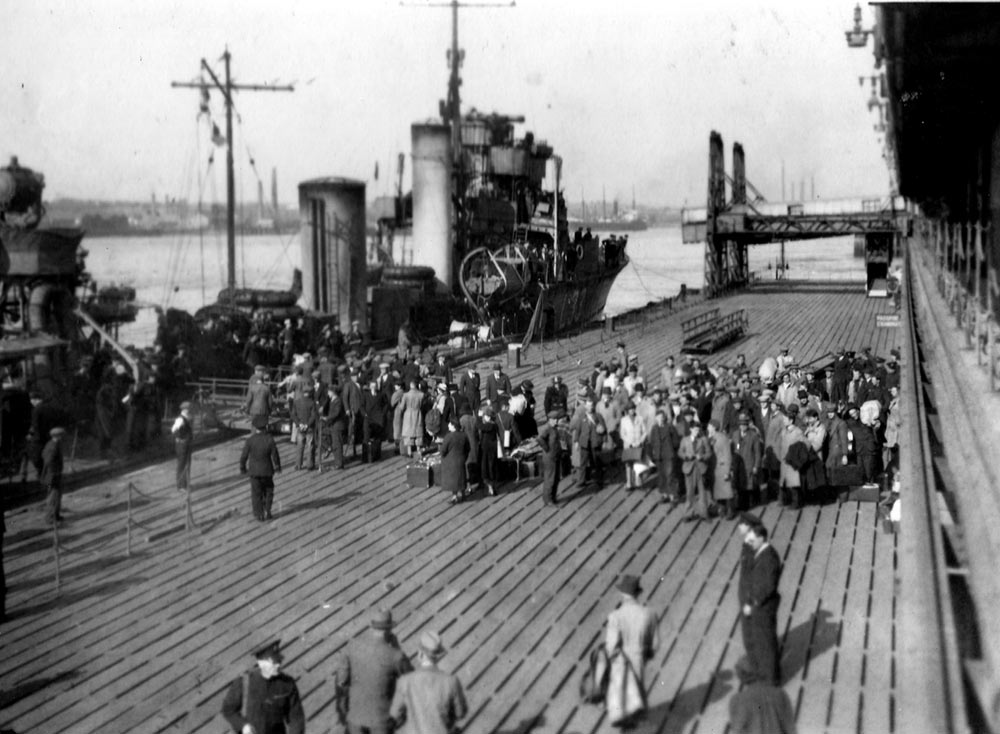 HMS Vivien (L33) berthed at Tilbury in May 1940 after returning from the Netherlands with refugees Montrose was 200 tons heavier and 20 foot longer than Vivien which displaced 1,300 tons and was 300 ft in length An LST Mark 3 displaced 5,000 tons with a full load and was 350 ft long Photographed by Sub Lt Herbert Walkinshaw RNVR |
| Montrose
was Cdr
Guy Neville-Rolfe's last seagoing command but he
remained in service until 1952. He was given a job with
"the Admiral Superintendent of Contract Built Shops based at
Newcastle" and moved there before buying his first house on the coast
at Whitley Bay. He was then offered the job of Area Officer of the Sea
Cadet Corps from Bury St Edmunds to the Scottish border and seemed to
be almost permanently on the road in his 1930's Alvis as he set himself
a target of two visits to each unit a year. For his dedication to the
work he was awarded the OBE on 1 January 1952. His final
appointment was a recruiting post in Derby. He finally retired on 30
October 1952 and moved into a purpose built bungalow at Duffield named
Heacham after the Rolfe family seat. He
was 89 when he died at Derby on 22 May 1988. At least three generations of Cdr Guy Neville-Rolfe's family served in the Royal Navy. He was born into the Navy, the son of Captain Herbert Neville-Rolfe RN (1854-1942) and the nephew of Admiral Ernest Neville Rolfe, C.B (1847 – 1909), and his second son married the daughter of Cdr I.R.C. Moultrie in 1963 and retired as Captain John Murray Neville-Rolfe (1937-2021). 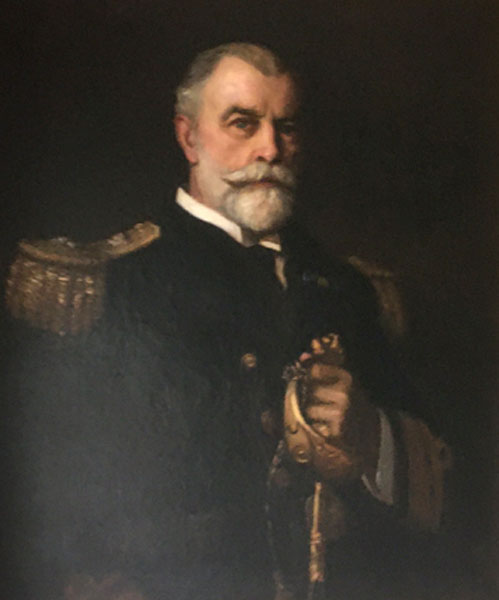 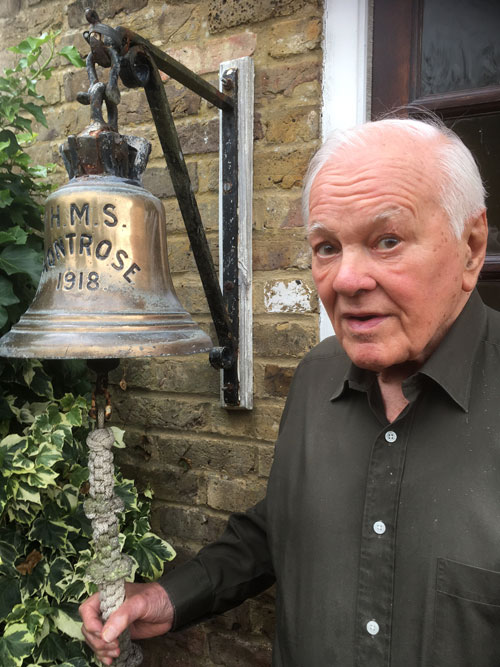 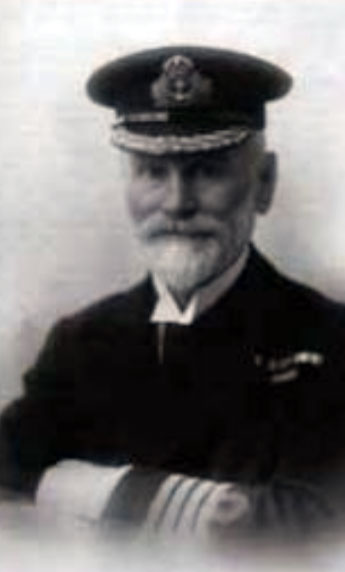 Admiral Ernest Neville-Rolfe (1847 - 1909), David Neville-Rolfe with the bell of HMS Montrose and Capt Herbert Neville-Rolfe (1854-1942) Capt Herbert Neville Rolfe was awarded the DSC for sinking a U-Boat with the armoured "yacht" assigned to him by the Admiralty The only photograph we had of the last Commanding Officer of HMS Montrose was the wedding photograph in the Daily Mirror on 19 January 1930 until
I traced their eldest son, David Edmund Neville-Rolfe born 6 February
1932 who served in the Army until the age of 39 and then went into the
insurance business. He married Yvonne de Cosson, the little girl
he met in Alexandria when they were both three and they had three
chldren, non of whom joined the Navy. He is photographed above with the
bell of HMS Montrose between his Grandfather and Great Uncle. Most of this account is based on Cdr Guy Neville-Rolfe's own memories recorded by him in 1969 when he was 71 plus some additional details written by his second son Captain John Murray Neville-Rolfe (1937-2021) in May 1998. A typescript of these documents will be published on the website as a PDF. |